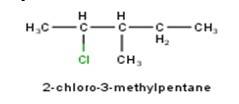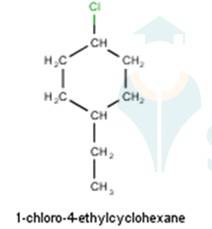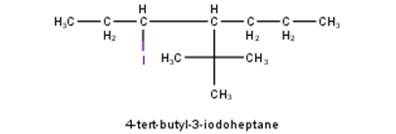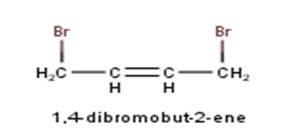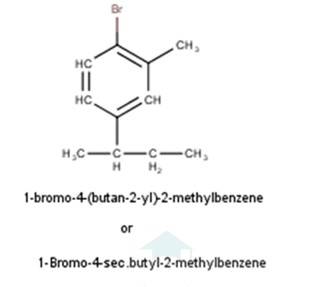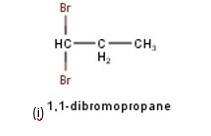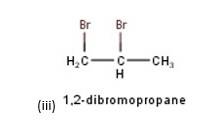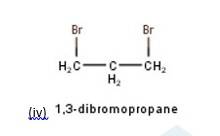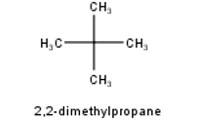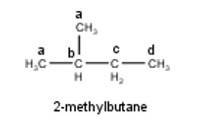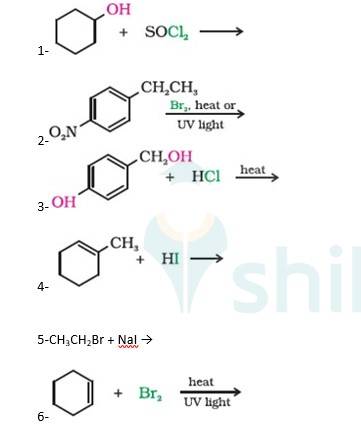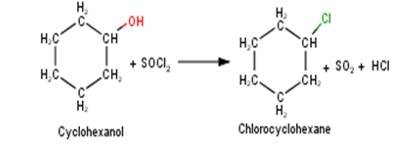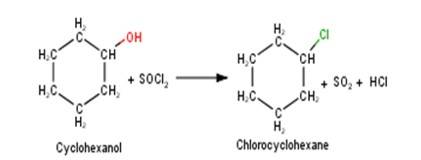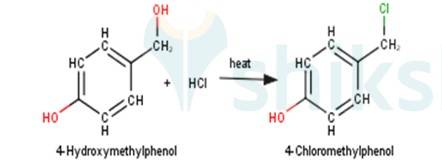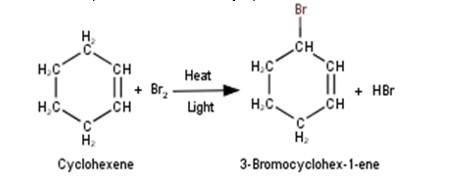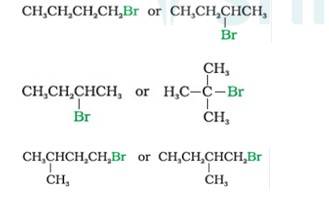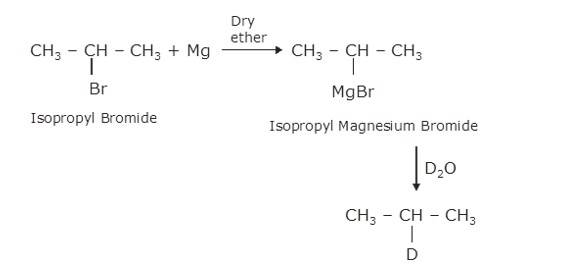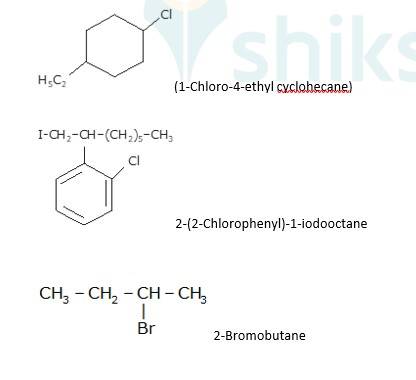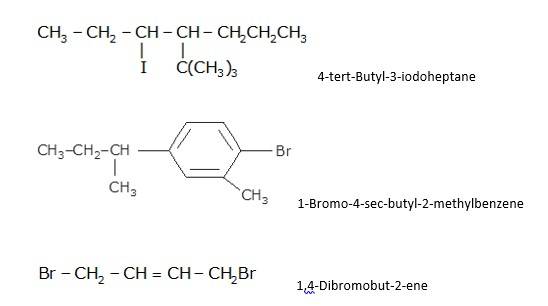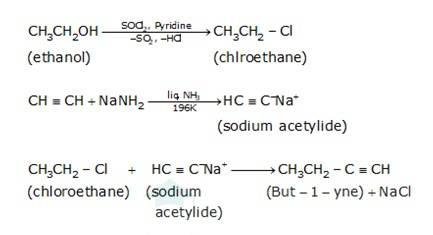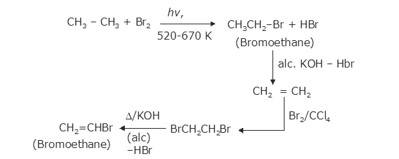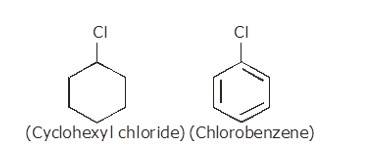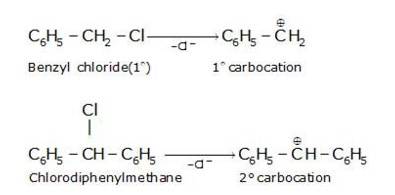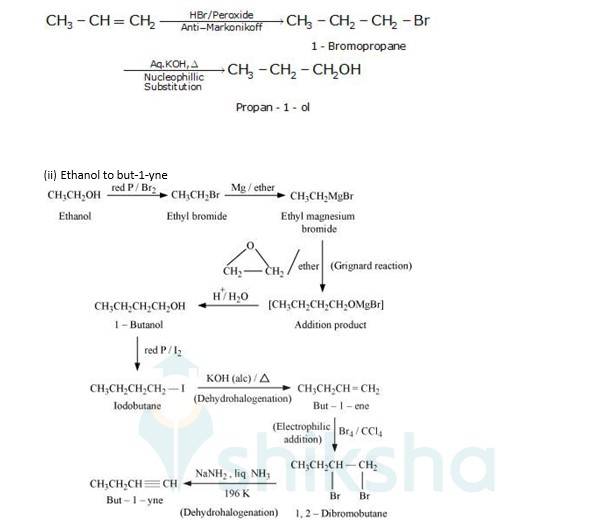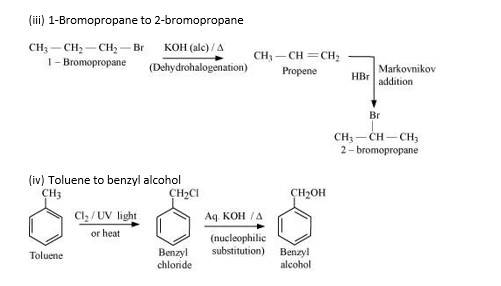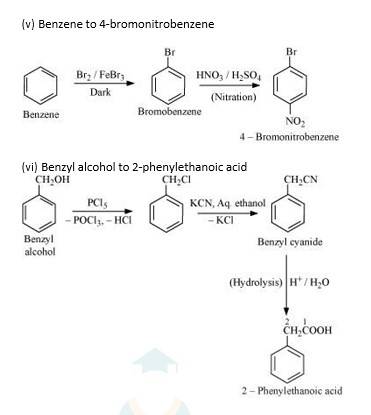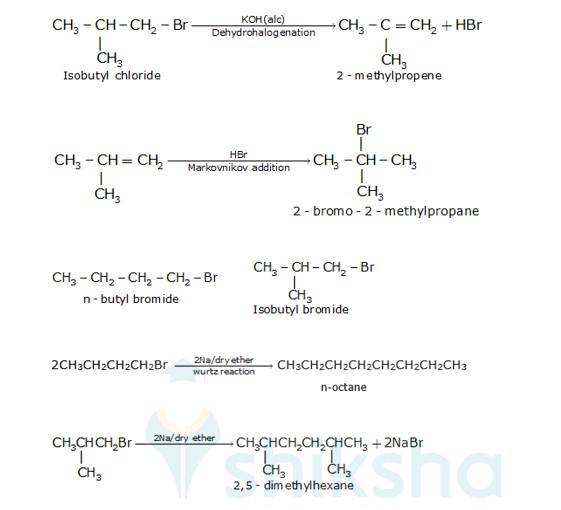
NCERT Chemistry Class 12 Haloalkanes and Haloarenes Solutions: NCERT Class 12 Chemistry solutions for Haloalkanes and Haloarenes chapter is available here.
Haloalkanes contain halogen atoms attached to the sp3 hybridised carbon atom of an alkyl group whereas haloarenes contain halogen atoms attached to sp2 hybridised carbon atoms of an aryl group. In NCERT Chemistry Class 12 Haloalkanes and Haloarenes chapter, students will study the important methods of preparation, physical and chemical properties and uses of Haloalkanes and Haloarenes compounds.
- Topics Covered in NCERT Class 12 Haloalkanes and Haloarenes Chapter
- NCERT Chemistry Class 12th Solution PDF - Haloalkanes and Haloarenes Chapter Download
- Haloalkanes and Haloarenes Solutions and FAQs
Topics Covered in NCERT Class 12 Haloalkanes and Haloarenes Chapter
The list of all topics covered in Haloalkanes and Haloarenes chapter of NCERT class 12 chemistry is given below:
- Classification
- On the Basis of Number of Halogen Atoms
- Compounds Containing sp3 C—X Bond (X= F, Cl, Br, I)
- Compounds Containing sp2 C—X Bond
- Nomenclature
- Nature of C-X Bond
- Methods of Preparation
- From Alcohols
- From Hydrocarbons
- Halogen Exchange
- Preparation of Haloarenes
- From hydrocarbons by electrophilic substitution
- From amines by Sandmeyer’s reaction
- Physical Properties
- Chemical Reactions
- Reactions of Haloalkanes
- Reactions of Haloarenes
- Polyhalogen Compounds
- Dichloromethane
- Trichloromethane (Chloroform)
- Triiodomethane (Iodoform)
- Tetrachloromethane (Carbon tetrachloride)
- Freons
- p,p’-Dichlorodiphenyltrichloroethane(DDT)
NCERT Chemistry Class 12th Solution PDF - Haloalkanes and Haloarenes Chapter Download
Haloalkanes and Haloarenes chapter will help students to prepare effectively for the exam and score good marks. Haloalkanes and Haloarenes are important topics for JEE Main as well as class 12 board exams.
The students can download here the Chemistry NCERT Class 12 PDF with solutions for free.
Download Here: NCERT Solution for Class XII Chemistry Haloalkanes and Haloarenes PDF
Haloalkanes and Haloarenes Solutions and FAQs
Get here all the questions of NCERT Class 12th Haloalkanes and Haloarenes Chapter.
Intext Q 10.1 Write structures of the following compounds: (i) 2-Chloro-3-methylpentane (ii) 1-Chloro-4- ethylcyclohexane (iii) 4-tert. Butyl-3-iodoheptane (iv) 1,4-Dibromobut-2-ene (v) 1-Bromo-4-sec. butyl- 2-methylbenzene.
A 10.1 From the name of the compound it is clear that the parent ring is pentane and chloro and methyl groups are attached in the straight chain at 2nd and 5th position respectively. Hence, the structure is as follows:
From the name of the compound given it is clear that the parent group is hexane with 2 attachments namely chloro and ethyl groups at 1 and 4 positions respectively. Hence, the structure is as follows: -
From the name of the compound given it is clear that the parent group is heptane with tertiary butyl and iodine groups attached at 4 and 3 positions respectively. Hence, the structure is as follows: -
From the name of the compound given it is clear that the parent group is an alkene with the unsaturation present in between 2nd and 3rd carbon and 2 bromine atoms attached at 1st and 4th carbon. Hence, the structure is as follows : -
From the name of the compound given it is clear that the parent group is benzene with bromine group attached at 1st carbon, secondary butyl group attached at 4th carbon and a methyl group attached at 2nd carbon. Hence, the structure is a follows : -
Intext Q 10.2 Why is sulphuric acid not used during the reaction of alcohols with KI?
A 10.2 In the presence of sulphuric acid (H2SO4), KI produces HI as follows : -
2KI + H2SO4 → 2KHSO4 + 2KI
Since H2SO4 is an oxidizing agent, it oxidizes HI (produced in the reaction to I2) as follows: -
2HI + H2SO4 → I2 + SO2 +;
As a result, the reaction between an alcohol and HI to produce alkyl iodide cannot occur. Therefore, sulphuric acid is not used during the reaction of alcohols with KI. Instead, a non-oxidizing acid such as H3PO4 is used in the reaction to get the desired product.
Intext Q 10.3 Write structures of different dihalogen derivatives of propane.
A 10.3 There are four different dihalogen derivatives of propane. The structures of these derivatives are as shown below: -
Intext Q 10.4 Among the isomeric alkanes of molecular formula C5H12, identify the one that on photochemical chlorination yields (i) A single monochloride. (ii) Three isomeric monochlorides. (iii) Four isomeric monochlorides
A 10.4 To have a single monochloride, there should be only one type of H-atom in the isomer of the alkane of the molecular formula C5H12. This is because of the fact that replacement of any H-atom leads to the formation of the same product. Therefore the isomer is 2,2-dimethylpropane.
To have three isomeric monochlorides, the isomer of the alkane of the molecular formula C5H12 should contain three different types of H-atoms. Therefore, the isomer is n-pentane. It can be observed that there are three types of H atoms labelled as a, b and c in n-pentane as shown below : -
To have four isomeric monochlorides, the isomer of the alkane of the molecular formula C5H12 should contain four different types of H-atoms in it. Therefore, the required isomer is 2-methylbutane. It can be observed that there are four different types of H-atoms labelled as a, b, c, and d in 2-methylbutane as shown below: -
Intext Q 10.5 Draw the structures of major monohalo products in each of the following reactions
A 10.5 1. Cyclohexanol will react with thionyl chloride to form Chlorocyclohexane with the evolution of sulphur dioxide and hydrogen chloride gas as shown below :
2. 4-Ethylnitrobenzene will undergo benzylic bromination in presence of heat or light. Now, as benzylic radicals are more stable therefore benzylic hydrogen is abstracted. Hence, the reaction yields 4-(1- Bromoethyl)nitrobenzene as a product
3. 4-Hydroxymethylphenol will react with hydrochloric acid under thermal conditions to yield 4- Chloromethylphenol a shown in the reaction below:
4. 1-Methylcyclohexene will react with hydrogen iodide via markovnikov’s addition mechanism to give 1- Iodo1-methylcyclohexane as shown in the reaction below: -
5.Bromoethane will react with sodium iodide in a Finkelstein reaction manner to yield Iodoethane in presence of dry acetone and heat as shown in the reaction below :
6. Cyclohexene reacts with bromine in presence of heat and light to undergo allylic bromination to yield 3-bromocyclohex-1-ene as the major product as shown in the reaction below :
Intext Q 10.6 Arrange each set of compounds in order of increasing boiling points. (i) Bromomethane, Bromoform, Chloromethane, Dibromomethane. (ii) 1-Chloropropane, Isopropyl chloride, 1- Chlorobutane.
A 10.6 The order of increasing boiling point is
- Chloromethane (CH3Cl)< Bromomethane (CH3Br) < Dibromomethane (CH2Br2)< Bromoform (CHBr3)
- Isopropyl chloride (C3H7Cl)< 1-Chloropropane (C3H7Cl) < 1-Chlorobutane(C4H9Cl)
Generally, boiling point increases with the molecular weight of the compound and decreases with the branching of the chain
Intext Q 10.7 Which alkyl halide from the following pairs would you expect to react more rapidly by an SN2 mechanism? Explain your answer.
A 10.7 In SN2 Reaction, the product will be formed in a single step with no intermediates. Nucleophile attack will be easier for simple halides than hindered haloalkanes. Therefore,
- Bromobutane (1°)reacts faster than 2-Bromobutane(2°)
- 2-Bromobutane(2°) reacts faster than 2-Bromo-2-methylpropane or tert-Butyl bromide (3°) 1-Bromo-3-methyl butane reacts faster than the 1-Bromo-2-methyl bu
- tane as the former is less hindered with respect to leaving halide than the later which is more hindered comparatively
Intext Q 10.8 In the following pairs of halogen compounds, which compound undergoes faster SN 1 reaction?
A 10.
Reason: SN1 occurs in two steps. In the first step, carbocation forms. The rate of reaction in SN1 depends upon the stability of the carbocation, greater the stability faster the reaction. Tertiary (3°) carbocation is more stable than secondary (2°), which is further stable than primary (1°)
By using this
- Tert-Butyl Chloride (3°) reacts faster than 3-Chloropentane (2°)
- 2-Chloro heptane (2°) is more reactive than 1-Chloro hexane (1°)
Intext Q 10.9 Identify A, B, C, D, E, R and R1 in the following:
A 10.9 (i) Bromocyclohexane is reacting with the metal Mg to give organo-metallic compound/Grignard reagent
i.e. Cyclohexyl Magnesium Bromide (A).
Grignard reagents are highly reactive with hydrocarbons to give alkanes. Cyclohexyl Magnesium Bromide reacts with water to cyclohexane (B) and Mg(OH)Br.
(ii) As the above reaction, haloalkane with metal Mg react to form the Grignard reagent, alkyl magnesium halide, RMgX, and further with hydrocarbon gives alkane.
∴ C is CH3CH(MgBr)CH3, a Grignard Reagent, R is CH3CH(Br)CH3 and D ≅ H
(iii) In the Wurtz Reaction, alkyl halide in the presence of sodium in dry ether gives the double number of
Now, in the reaction 2,2,3,3-tetramethyl butane is formed after the alkyl halide reacting in the presence of sodium in dry ether.
∴ Number of carbons will be 3 in R1 R1 –X is CH3C(X)(CH3)CH3
And the remaining reaction is same as the above i.e. alkyl halide reacting with Magnesium to give Grignard Reagent (D) and further with hydrocarbon H2O to give alkane (E)
∴ D is CH3C(CH3)(CH3)MgBr E is CH3CH(CH3)CH3
Exercise Q 10.1 Name the following halides according to IUPAC system and classify them as alkyl, allyl, benzyl (primary, secondary, tertiary), vinyl or aryl halides: (i) (CH3) 2CHCH(Cl)CH3 (ii) CH3CH2CH(CH3 )CH(C2H5 )Cl (iii) CH3CH2C(CH3 ) 2CH2 I (iv) (CH3 ) 3CCH2CH(Br)C6H5 (v) CH3CH(CH3 )CH(Br)CH3 (vi) CH3C(C2H5 ) 2CH2Br (vii) CH3C(Cl)(C2H5 )CH2CH3 (viii) CH3CH=C(Cl)CH2CH(CH3 ) 2 (ix) CH3CH=CHC(Br)(CH3 ) 2 (x) p-ClC6H4CH2CH(CH3 )2 (xi) m-ClCH2C6H4CH2C(CH3 )3 (xii) o-Br-C6H4CH(CH3 )CH2CH3
A 10.1
(i) 2-chloro-3-methylbutane, (2◦ alkyl halide)
Explanation: The Cl atom is attached with two alkyl groups therefore 2◦ alkyl halide.
(ii) 3-chloro-4-methylhexane (2◦ alkyl halide)
Explanation: The Cl atom is attached with two alkyl groups therefore 2◦ alkyl halide.
(iii) 1-iodo-2,2-dimethylbutane (1◦ alkyl halide)
Explanation: The atom I is attached with one alkyl group therefore 1◦ alkyl halide.
(iv) 1-bromo-3,3-dimethyl-1-phenylbutane (2◦ benzylic halide)
Explanation: The atom Br is attached with two alkyl groups with the benzene group therefore 2◦ benzylic halide.
(v) 2-bromo-3-methylbutane (2◦ alkyl halide)
Explanation: The atom Br is attached with two alkyl groups therefore 2◦ alkyl halide.
(vi) 1-bromo-2-ethyl-2-methylbutane (1◦ alkyl halide)
Explanation: The atom Br is attached with one alkyl group therefore 1◦ alkyl halide.)
(vii) 3-chloro-3-methylpentane (3◦ alkyl halide)
Explanation: The atom Cl is attached with three alkyl groups therefore 3◦ alkyl halide.
(viii) 3-chloro-5-methylhex-2-ene (vinylic halide)
Explanation: The atom Cl is attached with the double bond i.e. at vinylic position ∴ vinylic halide.)
(ix) 4-bromo-4-methylpent-2-ene (allylic halide)
Explanation: The Br atom is attached with the carbon next to the double bond i.e. at allylic position therefore allylic halide.
(x) 1-chloro-4-(2-methylpropyl)benzene (aryl halide)
Explanation: The Cl atom is attached with the benzene i.e. at aryl position therefore aryl halide.
(xi) 1-chloro-3-(2,2-dimethylpropyl)benzene (1◦ benzylic halide)
Explanation: The Cl is attached with one alkyl group at the benzene carbon therefore 1◦ benzylic halide.
(xii) 1-bromo-2-(1-methylpropyl)benzene (aryl halide)
Explanation: The Br is attached with the benzene i.e. at aryl position therefore aryl halide.
Exercise Q 10.2 Give the IUPAC names of the following compounds:
(i) CH3CH(Cl)CH(Br)CH3 (ii) CHF2CBrClF (iii) ClCH2C≡CCH2Br (iv) (CCl3 ) 3CCl (v) CH3C(p-ClC6H4 ) 2CH(Br)CH3 (vi) (CH3 ) 3CCH=CClC6H4 I-p
A 10.2
CH3CH(Cl)CH(Br)CH3: 2-Bromo-3-chlorobutane
- Write the name of side substituent according to the alphabetical order. Example: bromo is written before chloro as B comes before
- Always use a hyphen {-} between a number and a Since Br is attached to 2 position and Cl is attached to third position i.e. it is written as 2-Bromo and 3-chloro.
- Lastly, write the name of the longest hydrocarbon chain e. butane of 4 carbons.
CHF2CBrClF :1-bromo-1-chloro-1,2,2-trifluoroethane
- While writing the IUPAC name, write the name of side substituent according to the alphabetical Eg: bromo is written before chloro and fluoro as B comes before C and F.
- Always use a hyphen {-} between a number and a Since Br is attached to first carbon and Cl Is also attached to first carbon i.e. it is written as 1-Bromo and 1-chloro.
- Since there are 3 F present so it is written as
- And at the last write the name of the longest hydrocarbon chain e. ethane of 2 carbons.
ClCHC≡CCH2Br: 1-bromo-4-chlorobut-2-yne
- While writing the IUPAC name, write the name of side substituent according to the alphabetical That is why bromo is written before chloro as B comes before C.
- Always use a hyphen {-} between a number and a Since Br is attached to 1 position and Cl isattached to fourthposition i.e. it is written as 1-Bromo and 4-chloro.
- Also there is a presence of triple bond at the second carbon so the suffix used for triple bond is “yne” along with the position of the bond i.e. but-2-yne
(CCl3)3CCl
2-(trichloromethyl)-1,1,1,2,3,3,3-heptachloropropane
Explanation:
- While writing the IUPAC name, write the name of side substituent according to the alphabetical
- Always use a hyphen {-} between a number and a
- Because of the presence of 3 CCl3 group tri is used as a
- Since 7 Cl atoms are present in all therefore hepta is used a prefix with the position of chlorine. And at the last write the name of the longest hydrocarbon chain e. propane)
CH3C(p-ClC6H4)2CH(Br)CH3
2-bromo-3,3-bis-(4-chlorophenyl)butane
Explanation:
- While writing the IUPAC name, write the name of side substituent according to the alphabetical
- Always use a hyphen {-} between a number and a
- Because of the presence of 2 (p-ClC6H2) group bis is used as a prefix instead of di because C6H4 contains itself contains numbers 6 &
- And at the last write the name of the longest hydrocarbon chain e. butane)
(CH3)3CCH=CClC6H4I-p
1-chloro-1-(4-iodophenyl)-3,3-dimethylbut-1-ene
Explanation:
- While writing the IUPAC name, write the name of side substituent according to the alphabetical
- Always use a hyphen {-} between a number and a
- Because of the presence of 2 methyl group di is used as a
- And the presence of double bond has the ending ‘ene’ and the presence of double bond at the first position is written as but-1-ene.)
Exercise Q 10.3 Write the structures of the following organic halogen compounds. (i) 2-Chloro-3-methylpentane (ii) p-Bromochlorobenzene (iii) 1-Chloro-4-ethylcyclohexane (iv) 2-(2-Chlorophenyl)-1-iodooctane (v) 2-Bromobutane (vi) 4-tert-Butyl-3-iodoheptane (vii) 1-Bromo-4-sec-butyl-2-methylbenzene (viii) 1,4- Dibromobut-2-ene
A 10.3
- Write the longest chain first e. in this case it is ‘pentane’ consisting of 5 carbons.
- Now, place the substituents at their respective place. For eg. Chlorine(Cl) at second carbon and methyl(CH3) at third carbon.
- Write the longest chain first i.e. in this case it is ‘benzene’ a cyclic structure consisting of 6 carbons
with 3 double bonds.
-
Now, place the substituent Bromine(Br) at the para position i.e. at the fourth carbon.
Exercise Q 10.4 Which one of the following has the highest dipole moment? (i) CH2Cl 2 (ii) CHCl 3 (iii) CCl4
A 10.4 The three dimensional structures of the three compounds along with the direction of dipole moment in each of their bonds are given below:-
CCl4 being symmetrical has zero dipole moment. In CHCl3, the resultant of the two C-Cl dipole moments is opposed by the resultant of C-H and C-Cl bonds. Since the dipole Moment of latter resultant is expected to be smaller than the former,CHCl3 has a finite dipole moment(1.03D)
In CH2Cl2, the resultant of two C-Cl dipole moments is reinforced by resultant of two C-H dipoles. Therefore, CH2Cl2(1.62D) has a dipole moment higher than that of CHCl3. Thus ,CH2Cl2 has the highest dipole moment.
Exercise Q 10.5 A hydrocarbon C5H10 does not react with chlorine in dark but gives a single monochloro compound C5H9Cl in bright sunlight. Identify the hydrocarbon.
A 10.5 The hydrocarbon with molecular formula C5H10 can either form a cycloalkane or an alkene. Since the compound does not react with Cl2in the dark, therefore it cannot be an alkene but must be a cycloalkane. Since the cycloalkane reacts with Cl2 in the presence of bright sunlight to give a single monochloro compound, C5H9Cl, therefore, all the ten hydrogen atoms of the cycloalkanes must be equivalent. Thus, the cycloalkane is cyclopentane.
Exercise Q 10.6 Write the isomers of the compound having formula C4H9Br.
A 10.6 Double bond equivalent is used to find the level of unsaturations present in an organic molecule.
DBE = C +1-H/2+X/2-N/2
Where C= number of carbon atoms present H=number of hydrogen atoms present N=number of nitrogen atoms present X=number of halogen atoms present Double bond equivalent (DBE) for C4H9Br
= 4+1-9/2+1/2
=0
So none of the isomers has a ring or unsaturation, so the isomers are positions or chain isomers as shown below in the table:
Exercise Q 10.7 Write the equations for the preparation of 1-iodobutane from (i) 1-butanol (ii) 1-chlorobutane (iii) but-1-ene.
A 10.7 1-butanol is treated with KI in the presence of H3PO4 where the OH is being replaced by the iodine and gives H2O and KH2PO4 as the by-product with 1-iodobutane as the final
- The conversion of 1-chlorobutane to 1-iodobutane simply takes place by treating the reactant with KI in the presence of acetone. The iodine from KI normally replaces the chlorine from the reactant and gives 1-iodobutane as the final product with KCl as the by product.
- The conversion of but-1-ene to 1-iodobutane takes place according to anti-markovnikoff (positive charged ion H+ goes to the carbon which has less number of hydrogens and negative part Br- goes to the carbon which has more number of hydrogens.) i.e. the attack of HBr on but-1-ene in the presence of peroxide gives 1-bromobutane as the intermediate which on treatment with NaI+Acetone gives 1- iodobutane as the final product and NaBr as the by-product.
Exercise Q 10.8 What are ambident nucleophiles? Explain with an example.
A 10.8 Ambident Nucleophiles are those nucleophilies which can attack through different sites. For example:-cyanide ions are a resonance hybrid of the following two structures:
It can attack through carbon to form cyanide and through N to form is O cyanide. Example: NO2, NO3 - etc.
Exercise Q 10.9 Which compound in each of the following pairs will react faster in SN2 reaction with –OH?
(i) CH3Br or CH3 I (ii) (CH3 ) 3CCl or CH3Cl
A 10.9
(i) Since I- ion is a better leaving group than Br- ion, therefore, CH3I reacts faster CH3Br in SN2 reaction with OH- ion.
Better the leaving group, faster is the SN2 reaction.
(ii) On steric grounds, 1◦ alkyl halides are more reactive than tert-alkyl halides in SN2 reactions. Therefore, CH3Cl will react at a faster rate than (CH3)3CCl in a SN2 reaction with OH- ion. (Bulkier the group, slower is the SN2 )
Exercise Q 10.10 Predict all the alkenes that would be formed by dehydrohalogenation of the following halides with sodium ethoxide in ethanol and identify the major alkene: (i) 1-Bromo-1-methylcyclohexane (ii) 2-Chloro-2-methylbutane (iii) 2,2,3-Trimethyl-3-bromopentane
A 10.10 (i) The reaction of 1-bromo-1-methylcyclohexane with sodium ethoxide in ethanol gives 2 products: - major and minor as shown below:
The 2 products are obtained because of the presence of two types of beta (β) hydrogen.
According to saytzeff rule, the alkene formed in greatest amount (major) is the one that corresponds to
removal of the hydrogen from the β-carbon having the fewest hydrogen substituents.
When the 1-bromo-1-methylcyclohexane reacts with sodium ethoxide in ethanol, removal of HBr takes place giving two products one major and the other minor.
(In the major product number of alpha hydrogen=5 and in the minor product no. of alpha product=4)
- The reaction of 2-chloro-2-methylbutane with sodium ethoxide in ethanol gives 2 products: - major and
The 2 products are obtained because of the presence of two types of beta (β) hydrogen.
According to saytzeff rule, the alkene formed in greatest amount (major) is the one that corresponds to removal of the hydrogen from the β-carbon having the fewest hydrogen substituents.
When the 2-chloro-2-methylbutane reacts with sodium ethoxide in ethanol, removal of HBr takes place giving two products one major and the other minor.
(In the major product number of alpha hydrogen=6 and in the minor product no. of alpha product=5)
- The reaction of 2,2,3-trimethyl-3-bromopentane with sodium ethoxide in ethanol gives 2 products: - major and
The 2 products are obtained because of the presence of two types of beta (β) hydrogen.
According to saytzeff rule, the alkene formed in greatest amount (major) is the one that corresponds to removal of the hydrogen from the β-carbon having the fewest hydrogen substituents.
When the 2,2,3-trimethyl-3-bromopentane reacts with sodium ethoxide in ethanol, removal of HBr takes place giving two products one major and the other minor.
(In the major product number of alpha hydrogen=6 and in the minor product no. of alpha product=2)
Exercise Q 10.11 How will you bring about the following conversions? (i) Ethanol to but-1-yne (ii) Ethane to bromoethene (iii) Propene to 1-nitropropane (iv) Toluene to benzyl alcohol (v) Propene to propyne (vi) Ethanol to ethyl fluoride (vii) Bromomethane to propanone (viii) But-1-ene to but-2-ene (ix) 1- Chlorobutane to n-octane (x) Benzene to biphenyl.(Advanced)
A 10.11
(i) Since the conversion of ethanol to but-1-yne involves the addition the two extra carbons that is why the conversion is carried out in 3 steps.
- In the first step ethanol is treated with thionyl chloride (SOCl2) in the presence of pyridine to give chloroethane
Exercise Q 10.12 Explain why (i) the dipole moment of chlorobenzene is lower than that of cyclohexyl chloride? (ii) alkyl halides, though polar, are immiscible with water? (iii) Grignard reagents should be prepared under anhydrous conditions?
A 10.12 sp2 hybrid carbon(s-character=33.33%) in chlorobenzene is more electronegative than a sp3-hybrid carbon(s-character=25%) in cyclohexylchloride, due to greater s-character. Thus, Carbon atom of chlorobenzene has less tendency to release electrons to Cl than carbon atom of cyclohexylchloride.
As a result,C-Cl bond in chlorobenzene is less polar than in cyclohexylchloride. Further due to delocalisation of lone pairs of electrons of the Cl atom over the benzene ring, C-Cl bond in cholorobenzene acquires some double bond character while the C-Cl in cyclohexylchloride is a pure single bond. In other words, C-Cl bond in chlorobenzene is shorter than in cyclohexylchloride. Since the dipole moment is a product of charge and distance, therefore, chlorobenzene has lower dipole moment than cyclohexylchloride due to lower magnitude of negative charge on the Cl atom and shorter C-Cl distance.(double bond is of shorter length than single bond)
- Alkyl halides are polar molecules, therefore their molecules are held together by dipole-dipole The molecules of H2O are held together by hydrogen bonds (H-bonds). Since the new force of attraction between water and alkyl halide molecules are weaker than the forces of attraction already existing between alkyl halide-alkyl halide molecule and water-water molecules, therefore alkyl halides are immiscible (not soluble) in water. Alkyl halide are neither able to form H-bonds with water nor are able to break the H-bonding network of water.
- Grignard reagents are very reactive. They react with moisture present in the apparatus to form
R-Mg-X + H-OH → R-H + Mg(OH)X
Thus Grignard reagents must be prepared under anhydrous conditions.
Exercise Q 10.13 Give the uses of freon 12, DDT, carbon tetrachloride and iodoform.
A 10.13
(i) Freon 12:- the chlorofluorocarbon compounds of methane and ethane are collectively known as freons. They are extremely stable,unreactive, non-toxic and non-corrosive. Example of Freon 12 is CCl2F2. It is mainly used in refrigeration and eventually makes its way into the atmosphere where it diffuses unchanged into the stratosphere. In stratosphere, Freon is able to initiate the radical chain reactions that can upset the natural ozone balance.
- DDT: - it stands for p, p’-Dichlorodiphenyltrichloroethane (DDT). It is mainly used as an
- Iodoform: - it was earlier used as an antiseptic but the antiseptic properties are due the liberation of free iodine and not due to the iodoform itself. Due to its objectionable smell, it has been replaced by other formulations containing iodine.
- Carbon tetrachloride (CCl4):- it is used as an industrial solvent for oils, fats, resins etc. and also in dry Used as a cleaning fluid both in industries, as a degreasing agent and in the home, as a spot remover and as a fire extinguisher.
Exercise Q 10.14 Write the structure of the major organic product in each of the following reactions:
A 10.14
8-CH3CH = C(CH3)2 + HBr
It is a markovnikoff reaction in which an alkene undergoes substitution reaction with hydrohalide, wherein a halo group is attached to that carbon atom which has largest no. Of alkyl groups attached to it.
Exercise Q 10.15 Write the mechanism of the following reaction:
ANSWER: The given reaction is a nucleophillic reaction:

The given reaction is an SN2 reaction. In this reaction, CN acts as the stronger nucleophile and attacks the carbon atom to which Br is attached in nBuBr.
And, CN- ion is an ambident nucleophile and can attack through both C and N. In this case, it attacks through the C-atom.
The mechanism is shown below:
Exercise Q 10.16 Arrange the compounds of each set in order of reactivity towards S N2 displacement: (i) 2- Bromo-2-methylbutane, 1-Bromopentane, 2-Bromopentane (ii) 1-Bromo-3-methylbutane, 2-Bromo-2-methylbutane, 2-Bromo-3-methylbutane (iii) 1-Bromobutane, 1-Bromo-2,2-dimethylpropane, 1- Bromo-2-methylbutane, 1-Bromo-3-methylbutane.
A 10.16 The reaction involves the approaching of the nucleophile to the carbon atom to which the leaving group is attached. When the nucleophile is sterically hindered(does not have any free space or very crowded), then the reactivity towards SN2 displacement decreases. Due to the presence of substituents, hindrance to the approaching nucleophile increases in the following order.
- Bromopentane < 2-bromopentane < 2-Bromo-2-methylbutane. The structures are shown below:
Hence, the increasing order of reactivity towards SN2 displacement is:
- Bromo-2-methylbutane < 2-Bromopentane < 1-Bromopentane
- The stearic hinderance in alkyl halides increases in the order of 1° < 2° < 3°, the increasing order of reactivity towards SN2 displacement is given as-
3° < 2° < 1°.
The structures are given below:
Hence, the given set of compounds can be arranged in the increasing order of their reactivity towards SN2 displacement as:
2-Bromo-2-methylbutane < 2-Bromo-3-methylbutane < 1-Bromo-3-methylbutane
- The stearic hinderance to the nucleophile in the SN2 mechanism increases with a decrease in the distance of the substituents from the atom containing the leaving group. Further, the stearic hinderance increases with an increase in the number of Therefore, the increasing order of steric hindrances in the given compounds is as below:
Exercise Q 10.17 Out of C6H5CH2Cl and C6H5CHClC6H5 , which is more easily hydrolysed by aqueous KOH.
A 10.17 Hydrolysis by KOH results in the formation of the carbocation. Those compounds which leads to the formation of stable carbocation are easily hydrolysed.C6H5CH2Cl leads to formation of 1°- carbocation, while C6H5CHClC6H5 forms 2°-carbocation, which is more stable than 1°-carbocation. Hence C6H5CHClC6H5, is hydrolyzed more easily than C6H5CH2Cl by aqueous KOH.
Exercise Q 10.18 p-Dichlorobenzene has higher m.p. than those of o- and m-isomers. Discuss.
A10.18 p-Dichlorobenzene is more symmetrical than o-and m-isomers. Because it fits more closely and easily in the crystal lattice than o-and m-isomers. Therefore, more energy is required to break the crystal lattice of p-dichlorobenzene. Therefore, p-dichlorobenzene is symmetrical and has a higher melting point and lower solubility than o-and m-isomers due to strong force of attraction in crystal.
Therefore more energy required to break lattice and will not easily be soluble.
Exercise Q 10.19 How the following conversions can be carried out? (i) Propene to propan-1-ol (ii) Ethanol to but-1-yne (iii) 1-Bromopropane to 2-bromopropane (iv) Toluene to benzyl alcohol (v) Benzene to 4-bromonitrobenzene (vi) Benzyl alcohol to 2-phenylethanoic acid (vii) Ethanol to propanenitrile (viii) Aniline to chlorobenzene (ix) 2-Chlorobutane to 3, 4-dimethylhexane (x) 2-Methyl-1-propene to 2-chloro-2-methylpropane (xi) Ethyl chloride to propanoic acid (xii) But-1-ene to n-butyliodide (xiii) 2-Chloropropane to 1-propanol (xiv) Isopropyl alcohol to iodoform (xv) Chlorobenzene to p-nitrophenol (xvi) 2-Bromopropane to 1-bromopropane (xvii) Chloroethane to butane (xviii) Benzene to diphenyl (xix) tert-Butyl bromide to isobutyl bromide (xx) Aniline to phenylisocyanide
A 10.19 (i) Propene to propan-1-ol
It is an antimarkovnikoff reaction in which under the presence of a peroxide an alkene undergoes substitution, wherein the halo group is attached to that carbon which has least no. Of alkyl groups attached to it.
Exercise Q 10.20 The treatment of alkyl chlorides with aqueous KOH leads to the formation of alcohols but in the presence of alcoholic KOH, alkenes are major products. Explain.
A 10.20 An aqueous solution, KOH almost completely ionizes to give OH-ions. OH- ion is a strong nucleophile(see the imp. note below), which leads the alkyl chloride to undergo a nucleophilic substitution reaction to form alcohol.
On the other hand, an alcoholic solution of KOH contains alkoxide (RO-) ion, it is a strong base. Thus, it can abstract a hydrogen ion from the beta-carbon of the alkyl chloride and form an alkene by eliminating a molecule of HCl.OH- ion is a much weaker base than RO- ion. Also, OH- ion is highly solvated (because more energy is released on solvation)in an aqueous solution and as a result, the basic character of OH-ion decreases.
Exercise Q 10.21 Primary alkyl halide C4H9Br (a) reacted with alcoholic KOH to give compound (b). Compound (b) is reacted with HBr to give (c) which is an isomer of (a). When (a) is reacted with sodium metal it gives compound (d), C8H18 which is different from the compound formed when n-butyl bromide is reacted with sodium. Give the structural formula of (a) and write the equations for all the reactions.
A 10.21 There are two primary alkyl halides having the formulaC4H9Br, They are n - butyl bromide and isobutyl bromide.
Therefore, compound (a) is either n-butyl bromide or isobutyl bromide.
Now, compound (a) reacts with Na metal to give compound (b) of molecular formula, C18H18 which is different from the compound formed when n-butyl bromide reacts with Na metal.
Hence, compound (a) must be isobutyl bromide. Thus, compound (d) is 2, 5-dimethylhexane.
It is given that compound (a) reacts with alcoholic KOH to give compound (b). Hence, compound (b) is 2- methylpropene.
Also, compound (b) reacts with HBr to give compound (c) which is an isomer of (a). Hence, compound (c) is 2-bromo-2-methylpropane.
Exercise Q 10.22 What happens when (i) n-butyl chloride is treated with alcoholic KOH, (ii) bromobenzene is treated with Mg in the presence of dry ether, (iii) chlorobenzene is subjected to hydrolysis, (iv) ethyl chloride is treated with aqueous KOH, (v) methyl bromide is treated with sodium in the presence of dry ether, (vi) methyl chloride is treated with KCN?
A 10.22 When n - butyl chloride is treated with alcoholic KOH, the formation of but - l - ene takes place. This reaction is a dehydrohalogenation reaction.
Chemistry Ncert Solutions Class 12th Exam

